The list of link is worth reading to : http://pla-netx.com/linebackn/guis/index.html
Graphical User Interface Timeline
This timeline lists all of the graphical user interface environments
that I have been able to find information about through my own research
and on the Internet. I want to be as historically accurate as I can, however
due to limited available information there may be some mistakes. See my
notes
section at the bottom of this page for known inaccuracies. If you see an
error and have additional information about it please e-mail
me.
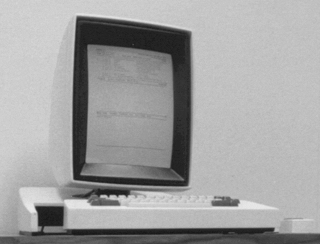 |
April 1973, the first operational Alto computer
is completed at Xerox PARC.
The Alto is the first system to pull together all of the elements of
the modern Graphical User Interface.
Features:
3-button mouse.
Bit-mapped display.
The use of graphical windows.
Ethernet network.
More
Info... |
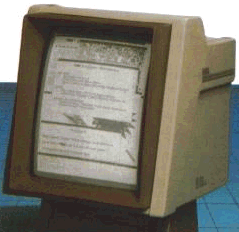
|
1980: Three Rivers Computer Corporation introduces
the the Perq graphical workstation.
More Info... |
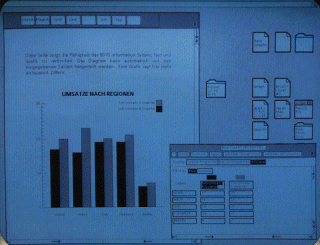 |
1981 June: Xerox introduces the Star, the commercial successor
to the Alto.
Notable features:
Double-clickable icons, overlapping windows, dialog boxes and a 1024*768
monochrome display.
More Info... |
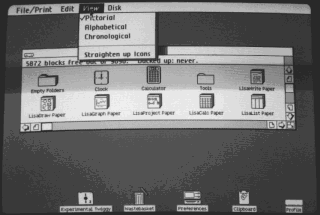 |
1983 January: Apple introduces the Lisa.
Notable features:
Pull down menus and menu bars.
More Info... |
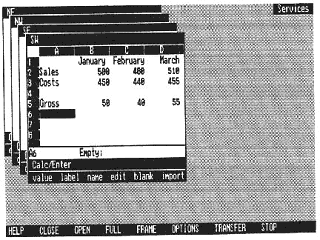
|
Visi Corp releases Visi On, the first integrated graphical software
environment for IBM PCs.
More
Info... |
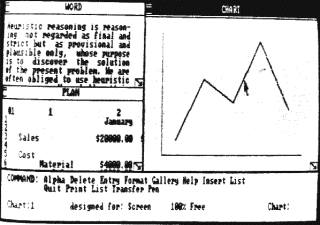 |
Microsoft announces their new "Windows" program for the
IBM PC but does not release it until 1985.
Notable features:
Is supposed to have overlapping / resizable windows.
More
Info... |
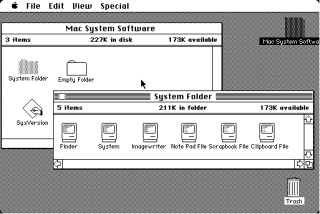 |
January 1984: Apple introduces the Macintosh.
More Info... |
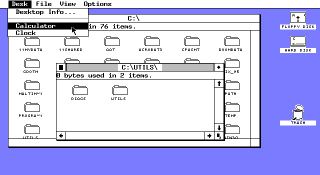 |
September: Digital Research announces its GEM icon/desktop
user interface for 8086- and DOS-based computers. It also was later ported
to the Atari ST.
More Info... |
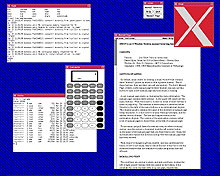
|
June: "window system X" announced at MIT.
Versions 1-6 were monochrome only, and ran on DEC VS100's displays
connected to VAXen and VAXstations 1 and 2.
Versions 8-10 dealt with color, for the VAXstation II/GPX. X10 is the
first version that saw widespread availability and use on many vendor's
systems.
Version 11 was redesign for higher performance, more window management
styles, extensibility and better graphics capability
More
Info.... |
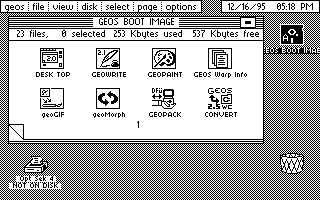 |
1985: Geos released for Commodore 64 and later the Apple
II.
More Info... |
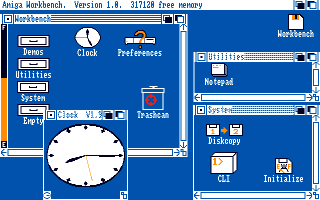 |
July: Commodore introduces the Amiga 1000 with the
Amiga Workbench Version 1.0.
More Info... |
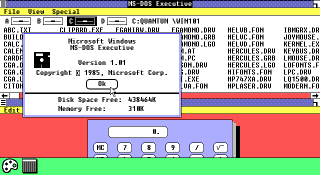 |
August: Microsoft finally releases the first version of Windows.
Features:
Windows can not be overlapped, but are instead "tiled".
Windows are not allowed to cover an area at the bottom of the screen
that is reserved for "iconized" programs.
More
Info... |
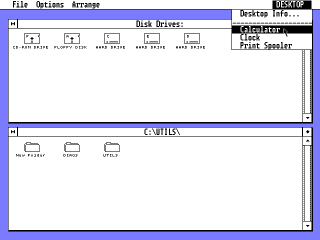 |
1986: Apple threatens to sue Digital Research because the
GEM desktop looked too much like Apple's Macintosh. Digital Research cripples
the desktop application so Apple will not sue.
The new GEM desktop now has just two unmovable, non-resizable windows
for file browsing.
More Info... |
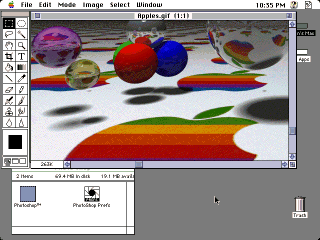 |
March 1987 - Apple introduces the Apple Macintosh
II, the first color Macintosh.
Features: 640*480*256 color with 24 bit color card available.
More Info... |
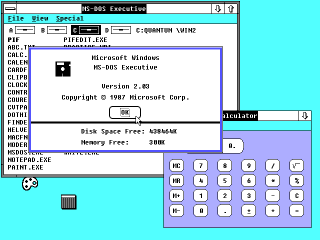 |
Microsoft releases the second version of Windows, version
2.03.
Features:
Finally has resizable / overlapping windows and new windowing controls.
More
Info... |
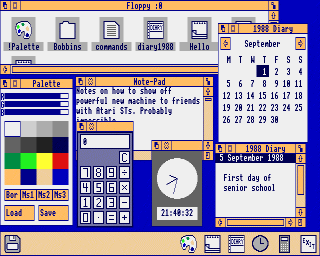 |
Acorn releases "Arthur" for the Acorn computer, it is the
basis for RISC OS. RISC OS 2 and 3 have a similar look, but an improved
feel.
More
Info... |
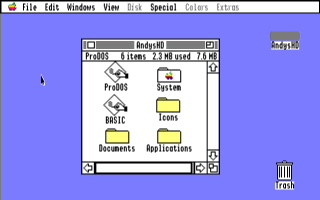 |
September 1988: Apple releases GS/OS, a 16-bit operating
system with a Macintosh-like GUI for the Apple IIGS.
More Info... |
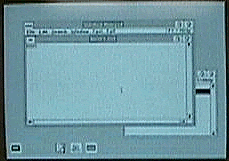
|
October: IBM releases OS/2 1.10 Standard Edition (SE) which added
a graphical user interface called Presentation Manager. (OS/2 1.0
was text mode only!) The 1.10 GUI was written by Microsoft and looked like
Windows 2.
More Info... |
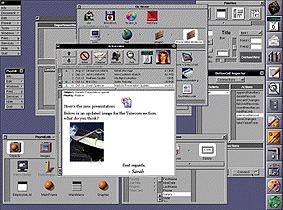
|
October: The NeXT Computer is released for $6500. It includes
a 25 MHz '30 processor, 8 MB RAM, 250 MB optical disk drive, math coprocessor,
digital processor for real time sound, fax modem, and a 17" monitor.
More Info... |
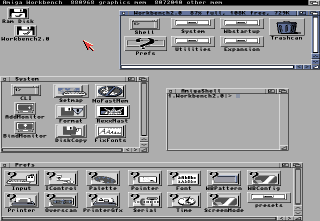 |
1990: Commodore releases Amiga Workbench 2
for the A3000.
Features: New 3d effects, a revised menu system and many other improvements.
More Info... |
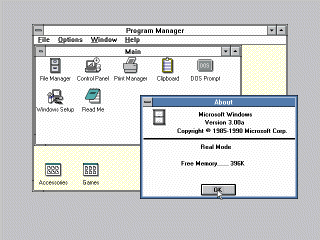 |
May 1990: Windows 3.0 released by Microsoft
Features: Program Manager shell.
More
Info... |
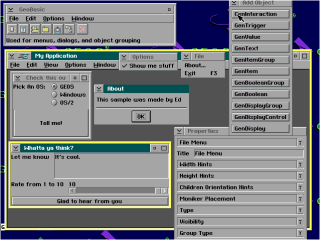 |
November: PC-GEOS released by GeoWorks.
More Info... |
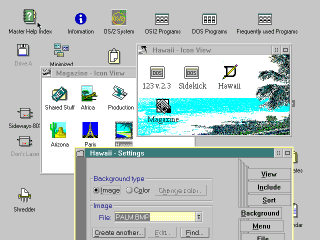 |
Spring of 1992: IBM releases OS/2 Version 2.0, a true 32-bit OS.
Features a new "Workplace Shell", an object oriented user interface
that is heavily integrated with the rest of the OS.
More Info... |
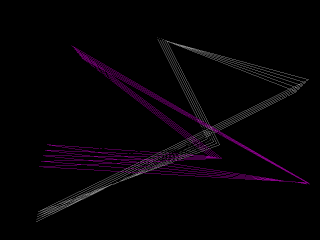 |
March: Microsoft introduces Windows 3.1. The user interface is basically
the same as Windows 3.0 but now includes their "multimedia" enhancements.
More
Info... |
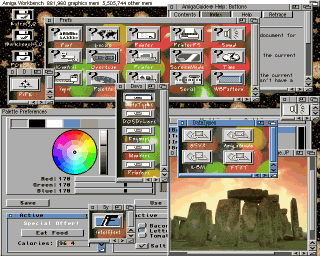 |
September: Amiga Workbench 3 released for AGA Amigas.
Features: Images for backgrounds, color pallet remapping.
More Info...
|
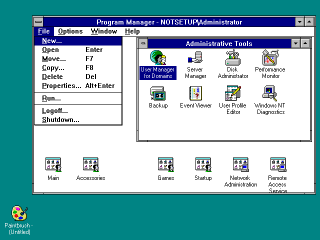 |
May 1993 Microsoft releases the first version
of Windows NT, their 32-bit OS. They give it the version number "3.1" and
use the same user interface they do for regular Windows 3.1. Made available
for Intel, Power PC, Alpha, and MIPS systems.
More
Info... |
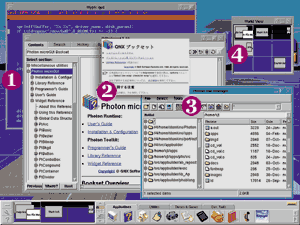 |
1994: QNX Software Systems releases the first embeddable
microkernel windowing system, the Photon microGUI.
More Info... |
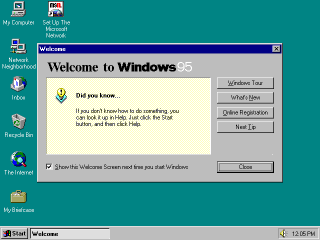 |
1995: Microsoft introduces Windows 95 on August
24th.
More
Info... |
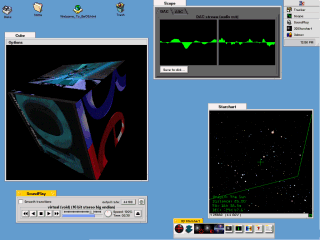 |
October: Be introduced BeOS at Agenda 96. The first version
was designed to run on a custom multiprocessor system known as the "BeBox".
Later made available for Power PC and Intel systems.
More Info... |
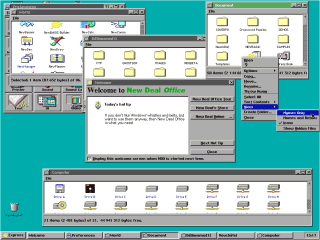 |
1996: New Deal releases New Deal Office 2.5, which was formerly
PC-GEOS.
More Info... |
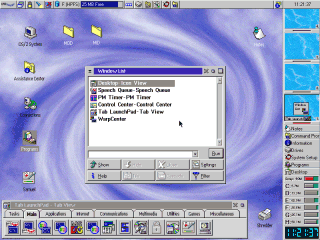 |
IBM Releases OS/2 Warp 4 with a significant facelift for
the Workplace Shell.
More Info... |
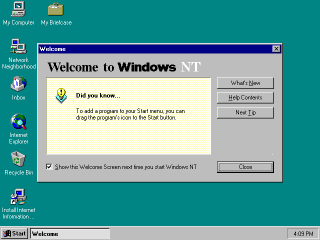 |
Microsoft releases Windows NT 4.0 with the same user interface
as Windows 95.
More
Info... |
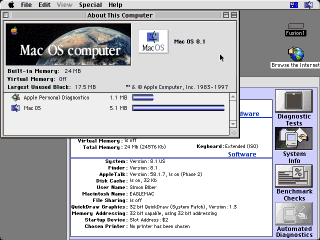 |
July 1997: Mac OS 8 is finally released. Selling
1.25 million copies in less than 2 weeks, it becomes the best-selling software
in that period.
More Info... |
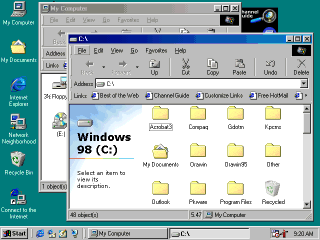 |
June 25, 1998: Microsoft releases Windows 98.
Features: Internet Explorer Web browser application takes over the role
of the Windows shell, advertising right on the desktop, entire help system
replaced by Internet Explorer.
More
Info... |
 |
November 22, 1998: Shane Brooks Releases 98Lite, an installer
that removes or prevents the installation of Internet Explorer with Windows
98.
Features No Internet Explorer or advertising, all the hardware support
of Windows 98, faster boot time, and the more responsive Windows 95 shell.
More
Info... |
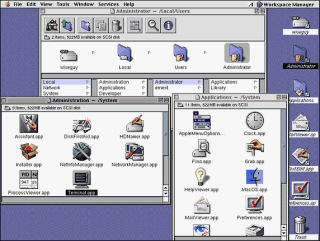 |
March 1999 - Apple releases Mac OS X Server,
a Unix based OS with their Macintosh GUI.
More Info... |
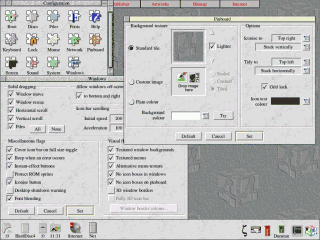 |
June 1999 - RISCOS Ltd releases RISC OS 4 for RiscPC, A7000
or A7000+ machines.
More
Info... |
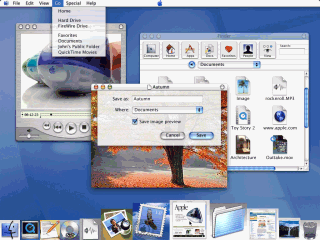 |
January 5, 2000: Apple announces Aqua,
the new look for their upcoming MacOS X client.
More Info... |
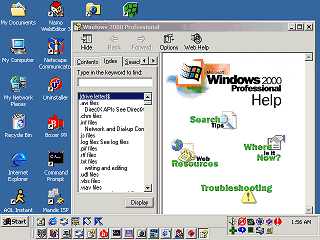 |
February 17, 2000: Microsoft Windows 2000 (AKA Windows NT 5) becomes
available in stores.
Features: The Internet Explorer web browser application finally takes
over the Windows NT UI.
More
Info... |
Notes:
I am limiting this timeline to systems that provide GUI services to
other applications, this is why I am not including individual graphical
DOS apps or older graphical programs such as Sketchpad
.
I am also not listing each version of a GUI system unless a significant
change has occurred in it. MacOS has kept the same basic user interface
since Version 1 and is therefore only mentioned a couple of times. Microsoft,
on the other hand thinks it is fun to make users learn a completely new
interface every few years, so each of the Windows interfaces is listed.
Issues:
X could just about have it's own history page. There is no way I can
list all of the different appearances of X here so I am just mentioning
it's creation. The picture is much more recent and not of the original
X.
The picture of NextStep is of a later version.
The picture of PC-Geos is from Geos Ensemble 2.X with the presentation
manager look.
The picture of BeOS is from a later version.
The color Mac screen shot is of MacOS 7.5.5, although these machines
shipped with MacOS 6
I have insufficient information about the history of Tandy Deskmate
and the Apollo workstation to place them on this timeline.
Back to the Graphical
User Interface Gallery













